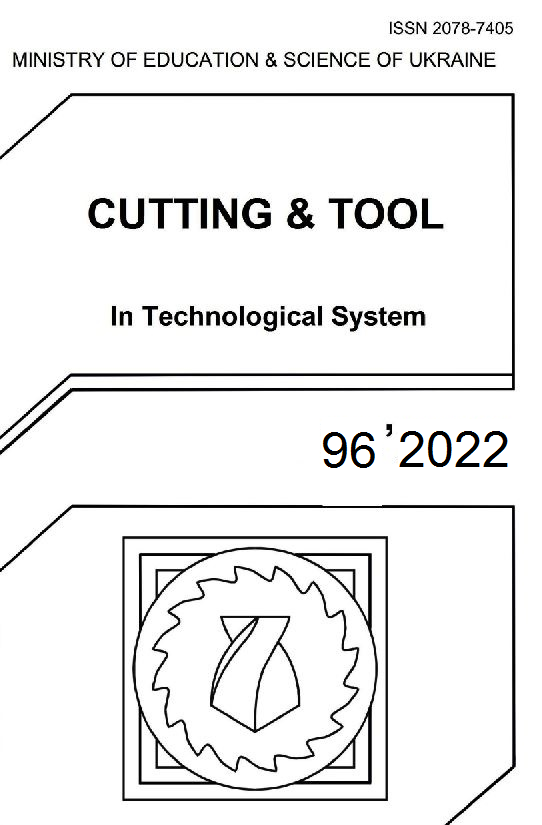THEORETICAL VALUE AND EXPERIMENTAL STUDY OF ARITHMETIC MEAN DEVIATION IN ROTATIONAL TURNING
DOI:
https://doi.org/10.20998/2078-7405.2022.96.08Abstract
The calculation method of the Arithmetic Mean Deviation (Ra) is presented for rotational turning. The necessary equations for the calculation of Ra are given beginning from the equation of the cut surface theoretical profile, and we determine the theoretical values in the studied range of the technological parameters. Cutting experiments with these data were performed and the roughness values of the machined surfaces were measured. Then we carried out a comparative analysis of the measured and the calculated values of the arithmetic mean deviation.
References
Byrne, G., Dornfeld, D., Denkena, B.: Advancing Cutting Technology. CIRP Annals - Manufacturing Technology Vol 52, Issue 2, pp. 483-507, 2003.
Savas V., Ozay C.: Analysis of the surface roughness of tangential turn-milling for machining with end milling cutter. Journal of Materials Processing Technology, ISSN: 0924-0136, Vol 186, pp. 279-283, 2007.
Armarego, E. J. A., Karri, V., Smith, A. J. R.: Fundamental studies of driven and self-propelled rotary tool cutting processes – I. Theoretical investigation. International Journal of Machine Tools and Manufacture, ISSN: 0890-6955, Vol 34, No 6, pp. 785-801, 1994.
Childs, T. H. C., Sekiya, K., Tezuka, R., Yamane, Y., Dornfeld, D.: Surface finishes from turning and facing with round nosed tools. Cirp Annals 57, 2008. pp. 89-92.
Tschätsch, H.: Applied Machining Technology. Springer Science & Business Media. 2010.
Shaw, M. C.: Metal Cutting Principles, Oxford University P, New York, 651 p., 2005.
Brechner, C., Esser, M., Witt, S.: Interaction of manufacturing process and machine tool. CIRP Annals - Manufacturing Technology Vol 58, pp. 588-607, 2009.
Struzikiewicz, G., Otko, T.: Dependence of shape deviations and surface roughness in the hardened steel turning. Key Engineering Materials, 581, pp. 443-448. 2014.
Paprocki, M., Wygoda, M., Wyczesany, P., Bazan, P.: Symptoms of wear HSS cutting tools in different wear stages. Manufacturing Technology 21(3), pp. 387-397. 2021.
Klymenko, G., Vasylchenko, Y., Kvashnin, V.: Modeling of cutting tools wear for lathes. Cutting & Tools in Technological System Vol. 93, pp. 138–148. 2020.
Beňo, J., Maňková, I., Vrábel, M., Karpuschewski, B., Emmer, T., Schmidt, K.: Operation Safety and Performance of Milling Cutters with Shank Style Holders of Tool Inserts. Procedia Engineering, 48, pp. 15-23. 2012.
Zębala, W., Gawlik, J., Matras, A., Struzikiewicz, G., Ślusarczyk, Ł.: Research of surface finish during titanium alloy turning. Key Engineering Materials, 581, pp. 409-414. 2014.
Klocke, F., Bergs, T., Degen, F., Ganser, P., Presentation of a novel cutting technology for precision machining of hardened rotationally symmetric parts, Production Engineering: Research and Development, vol. 7, pp. 177-184, 2013.
Degen, F., Klocke, F., Bergs, T., & Ganser, P.: Comparison of rotational turning and hard turning regarding surface generation. Production Engineering, 8(3), pp. 309-317., 2014.
He, C.L. Zong, W.J. Zhang, J.J.: Influencing factors and theoretical modeling methods of surface roughness in turning process: State-of-the-art. International Journal of Machine Tools and Manufacture, Volume 129, pp. 15-26, 2018.
Dyadya, S., Kozlova, Y., Germashev, A., Logominov, V.: Simulation of the machined surface after end milling with self-oscillations. Cutting & Tools in Technological System Vol 94, pp. 19–27, 2021.
Guo, H., Kang, M., Zhou, W.: Prediction of Surface Roughness and Optimization of Process Parameters for Slow Tool Servo Turning. Manufacturing Technology 21(5), pp. 616-626., 2021.
ISO4287:1997: Geometrical Product Specifications (GPS) — Surface texture: Profile method — Terms, definitions and surface texture parameters, 1997.
Sztankovics, I.: A forgácsolt felület analitikus meghatározása rotációs esztergálásnál. (“Analytical description of the cut surface in rotational turning”, in Hungarian) Multidiszciplináris Tudományok: A Miskolci Egyetem Közleménye 11: 4 pp. 102-110., 9 p. (2021).
Downloads
Published
Issue
Section
License
Copyright Notice
Authors who publish with this Collection agree to the following terms:
1. Authors retain copyright and grant the Collection right of first publication with the work simultaneously licensed under a Creative Commons Attribution License that allows others to share the work with an acknowledgement of the work's authorship and initial publication in this Collection.
2. Authors are able to enter into separate, additional contractual arrangements for the non-exclusive distribution of the Collection's published version of the work (e.g., post it to an institutional repository or publish it in a book), with an acknowledgement of its initial publication in this Collection.
3. Authors are permitted and encouraged to post their work online (e.g., in institutional repositories or on their website) prior to and during the submission process, as it can lead to productive exchanges, as well as earlier and greater citation of published work.

